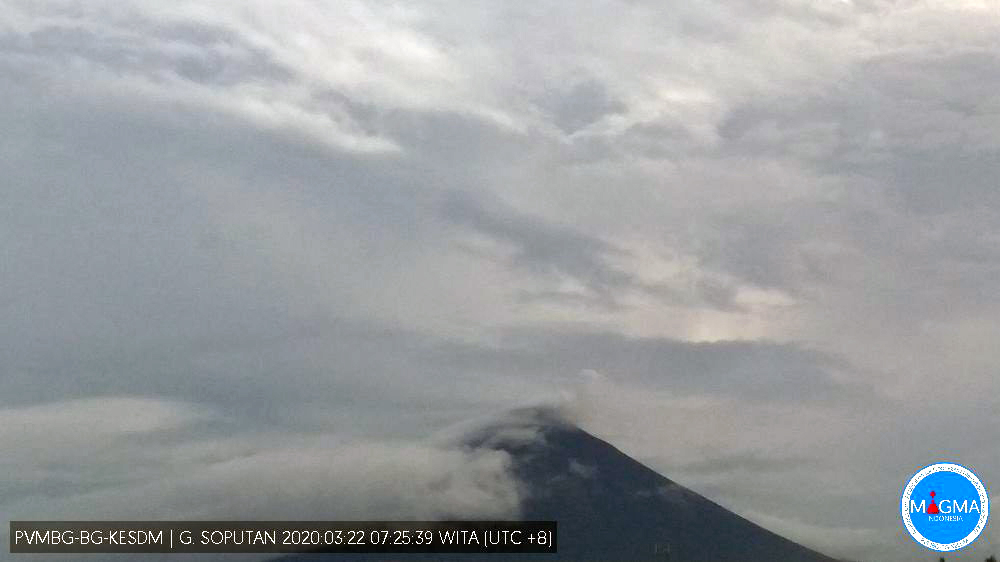Report on Soputan (Indonesia) — May 2020
Bulletin of the Global Volcanism Network, vol. 45, no. 5 (May 2020)
Managing Editor: Edward Venzke.
Edited by Kadie L. Bennis.
Soputan (Indonesia) Minor ash emissions during 23 March and 2 April 2020
Please cite this report as:
Global Volcanism Program, 2020. Report on Soputan (Indonesia) (Bennis, K.L., and Venzke, E., eds.). Bulletin of the Global Volcanism Network, 45:5. Smithsonian Institution. https://doi.org/10.5479/si.GVP.BGVN202005-266030
Soputan
Indonesia
1.112°N, 124.737°E; summit elev. 1785 m
All times are local (unless otherwise noted)
Soputan is a stratovolcano located in the northern arm of Sulawesi Island, Indonesia. Previous eruptive periods were characterized by ash explosions, lava flows, and Strombolian eruptions. The most recent eruption occurred during October-December 2018, which consisted mostly of ash plumes and some summit incandescence (BGVN 44:01). This report updates information for January 2019-April 2020 characterized by two ash plumes and gas-and-steam emissions. The primary source of information come from the Pusat Vulkanologi dan Mitigasi Bencana Geologi (PVMBG) and the Darwin Volcanic Ash Advisory Center (VAAC).
Activity during January 2019-April 2020 was relatively low; three faint thermal anomalies were observed at the summit at Soputan in satellite imagery for a total of three days on 2 and 4 January, and 1 October 2019 (figure 17). The MIROVA (Middle InfraRed Observation of Volcanic Activity) based on analysis of MODIS data detected 12 distal hotspots and six low-power hotspots within 5 km of the summit during August to early October 2019. A single distal thermal hotspot was detected in early March 2020. In March, activity primarily consisted of white to gray gas-and-steam plumes that rose 20-100 m above the crater, according to PVMBG. The Darwin VAAC issued a notice on 23 March 2020 that reported an ash plume rose to 4.3 km altitude; minor ash emissions had been visible in a webcam image the previous day (figure 18). A second notice was issued on 2 April, where an ash plume was observed rising 2.1 km altitude and drifting W.
 |
Figure 18. Minor ash emissions were seen rising from Soputan on 22 March 2020. Courtesy of MAGMA Indonesia. |
Geological Summary. The Soputan stratovolcano on the southern rim of the Quaternary Tondano caldera on the northern arm of Sulawesi Island is one of Sulawesi's most active volcanoes. The youthful, largely unvegetated volcano is the only active cone in the Sempu-Soputan volcanic complex, which includes the Soputan caldera, Rindengan, and Manimporok (3.5 km ESE). Kawah Masem maar was formed in the W part of the caldera and contains a crater lake; sulfur has been extracted from fumarolic areas in the maar since 1938. Recent eruptions have originated at both the summit crater and Aeseput, a prominent NE-flank vent that formed in 1906 and was the source of intermittent major lava flows until 1924.
Information Contacts: Pusat Vulkanologi dan Mitigasi Bencana Geologi (PVMBG, also known as Indonesian Center for Volcanology and Geological Hazard Mitigation, CVGHM), Jalan Diponegoro 57, Bandung 40122, Indonesia (URL: http://www.vsi.esdm.go.id/); MAGMA Indonesia, Kementerian Energi dan Sumber Daya Mineral (URL: https://magma.vsi.esdm.go.id/); Darwin Volcanic Ash Advisory Centre (VAAC), Bureau of Meteorology, Northern Territory Regional Office, PO Box 40050, Casuarina, NT 0811, Australia (URL: http://www.bom.gov.au/info/vaac/); MIROVA (Middle InfraRed Observation of Volcanic Activity), a collaborative project between the Universities of Turin and Florence (Italy) supported by the Centre for Volcanic Risk of the Italian Civil Protection Department (URL: http://www.mirovaweb.it/); Sentinel Hub Playground (URL: https://www.sentinel-hub.com/explore/sentinel-playground).


